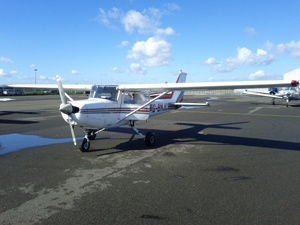If you've never seen The Amazing Race, you probably should - half gameshow, half reality show and all holiday porn, it's one of my favourite sit-down-and-watch shows.
The reason I mention it is that at the end, on the finish line, the winners arrive and look slightly stunned that they've won a million dollars while Phil (the host) recounts how many miles they've travelled, countries they've seen, and continents they've visited.
Flying only once a week plus the Olympics is why it took ages. You could do it all in a month if you flew every day.
I feel a bit like that final moment. Fourteen months, twelve planes and several flight-interrupting world events later and I've finally passed my skills test and obtained my Private Pilot's License.
It wasn't easy to even get the test - it's taken four attempts until the weather has even been good enough, thanks to the great British winter (I do love a bit of a moody day, but only when I'm in the Scottish Highlands overlooking a loch).
The way the test works is reasonably simple; the examiner is with you in the plane the entire time (flying solo is tested before in the QXC). The first half is a navigation exercise over a predetermined route, followed by a diversion; the second half is a series of manoeuvres, circuits and landings at the examiner's instructions, somewhat like a driving test.
Steep turns can go up to 60°, which is a crazy angle - at that point you're pulling 2G worth of force!
As an idea of quite how many things there are to do, the ones I can remember from the top of my head are: climbing, descending, normal turns, steep turns (45°), four different types of stall recovery, spiral dive recovery, slow flight, two types of simulated engine failure, normal circuits, normal landings, flapless landings, glide landings, bad weather circuits and short field landings. I'm sure there's more.
You practice all of these during your training, of course, but it's a different thing when you have an examiner next to you, strict limits set by the CAA, and you've already done over an hour of the best navigation you can.
All in all, it takes around two and a half hours of flight time - not to mention the hour or more you spend preparing the aircraft and briefing, and the half-hour debrief. Roll into that the fact that it's winter and sunset is at 4pm and it means a pretty early start and an exhausting day.
There were some enjoyable moments, though; with the winds at 2,000 ft being incredibly strong (around 55 knots) the slow flight segments left the plane literally hovering in the air. I wasn't expecting to be able to do that without a helicopter.
Eventually, I'll head across the Channel to France for a short jaunt, but that takes some working up to.
Was it worth it? Of course it was - just the learning itself has been fun, but getting the license adds all sorts of freedoms to that. Once it arrives - it can take a few weeks - I plan to fly a little bit here and there to keep in practice while eyeing up a longer trip (the West Country or the Scottish Borders) for some good cross-country practice.
Of course, flying in a private plane is usually more expensive than a scheduled commercial flight - it's around £100 an hour if you're lucky - and so it's not a terribly practical way of getting around. Now, if you'll excuse me, I'm off to see if I can convince a conference to help cover a new type of travel cost...


